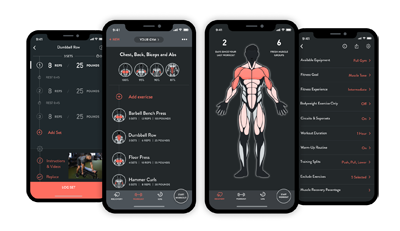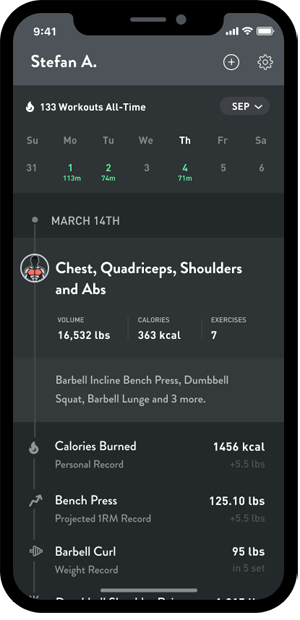Press Releases
Fitbod releases Android version of its popular data-driven workout app
Thousands of users on Fitbod iOS version; Android version dramatically expands its reach

The Apple Store chart-topping fitness app Fitbod (an App Store Editors’ Choice) that uses sophisticated data analytics to automatically build personalized daily workout routines, has now found a home on the Android platform, greatly expanding its reach—the app has a rating of 4.8 on the App Store for iOS, based on more than 91,000 reviews. A trial version of the Android version can be downloaded on the Google Play Store, https://bit.ly/37c8sUW, or the Fitbod website, https://fitbod.me. Fitbod takes the guesswork out of exercising by recommending workouts geared to each person’s fitness goals, level of fitness and physical condition. Guided by best practices in strength training and fitness science, Fitbod is a fitness lover’s dream, making workouts efficient, fun, and optimizing results for everyone from exercise novices to advanced athletes. The good news is that for all its sophistication, Fitbod is an affordable tool for nearly everyone. After three complimentary trial workouts, users can subscribe to the app for only $9.99 per month or get an annual subscription for $59.99. Fitbod generates a new personalized workout whenever you need it, taking into account what equipment and time is available, the user’s workout preferences and limitations, and information logged in from previous workouts. Fitbod’s routines can be built from more than 400 pieces of gym equipment, including specially designed routines for the BOSU® Balance Trainer. Users who want to work out at home can even choose bodyweight-only routines that require no gym equipment. The app was originally launched for iOS on the App Store in 2015. It is a 2019 Apple Store Editor’s Choice pick and has a 4.8 rating based on more than 91,000 reviews. Fitbod was created by co-founders Allen Chen and Jesse Venticinque to take advantage of breakthroughs in data analytics that make it possible to create fitness routines that are personalized while being based on best practices in strength training and fitness science. Prior to co-founding Fitbod, Venticinque, with a background in human-computer interaction and cognitive sciences (Carnegie Mellon University and UCLA), led mobile product design efforts at LinkedIn and is a startup veteran of companies such as Slideshare, Altschool and Predictify. “Consumer fitness tech today is like Google Maps without the directions feature. We have data-rich maps of people’s physical activity, but fail to help them navigate towards real results,” said Venticinque. “Fitbod bridges the gap, enabled by cutting edge personalization technology such as machine learning and predictive analytics. Resistance-training is the perfect type of exercise for this application. The activity naturally produces highly structured data (sets, reps, weight, equipment, etc.) and people vary widely in physical capability, making personalization critical to providing value.” Allen Chen had a computer engineering background and worked in the financial industry as a high-frequency trading strategist. He used machine learning and data analytics to develop optimized trading and portfolio strategies for clients. “Through my lifelong passion for strength and sports training, I realized that the data analytics approach used to design and engineer investment strategies could be leveraged to create optimal fitness plans as well,” he said. “It may seem counter-intuitive that algorithms could guide such a human activity as strength training but actually the data helps to personalize and humanize the workout experience.” Chen explained that according to fitness experts, daily routines need to vary from day to day in order to achieve best results. People’s lifestyles also dictate that exercise routines should be flexible. Depending on the day and circumstances, people may have a long or a short amount of time to work out. They may choose to go to the gym, work out at home, or may be on the road without access to their usual facilities and equipment. Fitbod takes all these factors into account and automatically designs an optimal workout routine for that day, based on what equipment and time period is available.” All Fitbod’s suggested exercises are based upon best practices in strength training and fitness science. Fitbod has teamed with highly regarded fitness pros Chris Matsui, Nick Cerone, and Irene Gardner, who help architect the routines Fitbod recommends to achieve each users fitness goals, from muscle tone and bodybuilding to Olympic and Powerlifting. Routines can include such contemporary fitness approaches as supersets and circuit training. Fitbod users can master their daily routine by using available videos and text to learn about each exercise and view the proper way to perform it. One of Fitbod’s strongest features is its ability to design workout routines that minimize the risk of injury. Fitbod tracks the user’s workout history and determines the muscle recovery state—which muscle groups need complete rest, or less intense exercise, so they won’t be overstrained. Over time, the daily workout routines become more individualized and challenging, pushing users to stretch their limits and reach their goals. Personal trainers have found value in using Fitbod to assist them in their work with clients. “Fitbod is like having a technical assistant to assist me as I work with my clients,” said personal fitness trainer Nick Cerone. “Fitbod does the heavy lifting when it comes to designing the daily routine, calculating calories burned, determining muscle recovery states and tracking progress. This frees me up to concentrate on motivating and encouraging my clients while I use my training expertise to make sure they use proper form. Fitbod is a win-win for everyone.” Personalizing workout routines The personalization process starts when new users create a profile by entering individual fitness information, including their height, weight, gender and age, their fitness experience, physical limitations, available equipment and their fitness goals. Fitness activities can be targeted toward general fitness, strength training, muscle tone, bodybuilding, powerlifting and even Olympic weightlifting. Height, weight, age, available equipment and available workout time can be modified as often as needed so that the recommended workout fits into the user’s day. Fitbod can also pull in physical data from Apple Health—another iOS app—to keep the user’s workout history up to date. Finally, the app analyzes data from previous workouts to determine the muscle recovery state—which muscle groups need to recuperate and shouldn’t be exercised until another day. Having considered these factors, Fitbod automatically creates a list of recommended exercises for the day, including the weights to be used and the number of required reps and sets. Users who are unfamiliar with an exercise can access instructional videos and text through the app. Each exercise is described, instructions are offered, and Fitbod tells them which muscle groups are involved. Exercise modifications are suggested for people with physical limitations. The workout routines can incorporate more than sixty categories of equipment including free weights, bars and benches, cable machines, weight machines and other equipment including resistance bands. The app will also recommend warm-up and cool-down exercises and cardio routines to augment the strength-focused exercises. To help keep subscribers motivated, Fitbod subscribers get a Weekly Workout Report which includes such stats as Total Weight Lifted, Number of Logged Workouts, Total Workout Duration, Total Calories Burned and Exercises Performed. Personal Bests and workout streaks are also recorded as Fitbod Achievements. About Fitbod Fitbod, Inc. is the developer of the Fitbod app, a technology platform that designs deeply personalized workout plans, allowing users to get maximum benefit from their fitness program. Using machine learning, data analytics, user data and exercise science best practices, the app creates optimized and personalized workout routines. In short, Fitbod helps users reach fitness goals efficiently and safely. Headquartered in San Francisco, Fitbod, Inc. is co-founded by Jesse Venticinque and Allen Chen. Fitbod is currently available for iOS devices at the App Store. For more information about Fitbod, please visit the website at https://fitbod.me. Follow Fitbod:On Facebook at https://facebook.com/fitbodappOn Twitter at https://twitter.com/fitbodappOn Instagram at https://instagram.com/fitbodapp# # #  Fitbod designs your daily workout routines based upon your physical characteristics and fitness level, your workout history, and your available equipment and time. Fitbod designs your daily workout routines based upon your physical characteristics and fitness level, your workout history, and your available equipment and time. Fitbod considers your workout history to determine which muscle groups are still in their recovery state and should be rested or used less strenuously. Fitbod considers your workout history to determine which muscle groups are still in their recovery state and should be rested or used less strenuously. To help you work out properly, Fitbod describes each recommended exercise. Video instruction is also available. To help you work out properly, Fitbod describes each recommended exercise. Video instruction is also available. Fitbod tracks your workout history, fitness progress and your personal bests to keep you motivated. Fitbod tracks your workout history, fitness progress and your personal bests to keep you motivated. |
 Frequently Asked Questions What is Fitbod? Fitbod is an easy to use app for iOS and Android devices. The app automatically builds recommended, personalized daily workout routines that optimize each subscriber’s ongoing fitness program, pushing them to get stronger and fitter, efficiently and safely. It can be used on smart phones and smart watches. What makes Fitbod unique? Fitbod uses sophisticated machine learning and data analytics to create daily personalized fitness routines that are matched to the fitness goals, physical characteristics, fitness level, workout preferences, available workout equipment and available time of each subscriber. Fitbod also takes into account the subscriber’s workout history, so that muscle groups are given appropriate time to recover from previous workouts before they are exercised again. Who can use Fitbod? Fitbod recommends that subscribers be at least 12 years of age, and make sure their physician has approved their participation in a regular exercise program in light of any physical limitations that might exist. Fitbod is just as beneficial to people who are starting a fitness program as it is for world-class athletes—and anyone in between—since the recommended workout routines are matched to their level of fitness and fitness goals. How does Fitbod learn about subscribers’ fitness needs? Fitbod learns by analyzing several types of information. Some information is supplied by the subscriber and some information is logged in automatically by the Fitbod app as it is used. As more information is supplied to or by the app over time, the more effective Fitbod becomes in personalizing its recommended workout routines, safely pushing subscribers to increase their strength and fitness. Among the data supplied by the subscriber are physical characteristics such as height, weight, age, gender and physical restrictions. The subscriber also inputs information about his or her fitness goals, and inputs what workout equipment is available on that day, noting any types of equipment he or she prefers not to use. The app also generates information about previous workouts to help determine which exercises would be most beneficial for the next workouts, given the available equipment. Fitbod analyzes which muscle groups would still be in their muscle recovery state and should be rested rather than exercised. The app also uses information from previous workouts to determine the weights, sets and reps that should be recommended for the next workout. How does Fitbod help subscribers reach their fitness goals? Fitbod is designed to help people build physical fitness through its recommended weight training exercises, but also takes into account the cardio-building activities that subscribers may participate in. For people who are new to working out or have had long layoffs since they last worked out, general fitness is typically the initial goal. Fitbod’s general fitness routines are designed to introduce them to a variety of exercises that encompass all the equipment available to them. If the goal is to look and feel fit by toning muscle and losing weight, Fitbod recommends circuit training routines that use lower weights but more reps. These routines typically involve less-complex exercises using more basic equipment. People interested in strength training are focused on getting stronger and lifting more weight. Fitbod recommends routines that focus on large muscle groups like chest, quads and back. The exercises tend to be more complex, involving higher weights and fewer reps. People who are interested in bodybuilding are focused on increasing their muscle mass and size. Fitbod recommends exercises that work both large muscle groups and those that isolate small muscle groups like biceps. These exercises involve higher weights and fewer reps. Advanced weightlifters typically want to pursue Powerlifting or Olympic weightlifting. These Fitbod routines focus on the specialized exercises that enable people to practice and master these formats. Are subscribers required to follow Fitbod’s recommended workouts? No—that is why Fitbod creates recommended workouts. Subscribers can customize their workouts as they see fit. They can adjust a recommended workout routine by:editing reps, sets, and weight for any exercisereplacing an exercise with a different exercise for the same muscle groupdeleting any exerciseediting target muscle groupsturning two or more exercises into a superset or circuitSubscribers can also create workouts from scratch from Fitbod’s exercise list that includes more than 400 exercises. For added convenience, subscribers can save created workouts for later use. When using self-designed workout routines, subscribers should simply log their exercises, monitor their muscle recovery state, view their exercise history, and rest assured that the Fitbod app will safely store their exercise history. How does Fitbod determine subscribers’ progress in getting fitter? Fitbod’s analytics and machine learning capabilities drive the app’s ability to determine progress and intensify or relax its recommended routines, depending on the progress subscribers are making. Subscribers need to maintain their proper height, weight, age information and make sure they log in their workout activity. They can enter their physical measurements manually or if Fitbod is configured to synch with Apple Health or other health monitoring smartphone or smartwatch apps, this information can be pulled into Fitbod automatically. Subscribers play a role, too, because they set their fitness experience level in their Fitbod profiles. Generally, it’s time for subscribers to move up to the next level when he or she has used the current fitness experience level for a couple of months, if the exercises in the routine are easy or boring, if the subscribers want more challenging movements in their workout, or if they feel better than their muscle recovery state indicates. If four or five of these conditions apply, it’s time to move up. How does Fitbod track subscribers’ progress? Fitbod subscribers automatically receive Weekly Workout Reports which are sent every Monday morning. These reports provide information on the past week’s workouts. Stats include Total Weight Lifted, number of logged workouts, total workout duration, total calories burned, performed exercises, number of performed exercises and Fitbod Achievements (personal bests). Does Fitbod work with other fitness apps? Complementarity is very important to Fitbod and so we are working hard to integrate our app with others. Currently, to build subscribers’ profiles on iOS devices, Fitbod can read and write data to Apple Health (weight, height, gender and age). Many of the Apple Health and Apple Watch workout routines—such as Indoor Run, Elliptical, Rower and Indoor Cycle—can be imported into Fitbod. The Activity app can pull in this data from the Apple Health app and use it to calculate calories burned during the workout. Integration with Fitbit is also available, so Fitbit subscribers can connect to their Fitbit account. Workout data from Fitbod can be posted to Fitbit. For extra motivation, Fitbod subscribers using the iOS version of the app can connect their Fitbod account to Strava, a social network for athletes. Strava subscribers can also post their Strava cardio fitness routines—Runs, Bike Rides and E-Bike Rides—since these affect the muscle recovery state and are considered when Fitbod designs their daily routine. Why are Fitbod’s recommended workout routines effective? Fitbod’s recommended routines are personalized and based on best practices in strength training and fitness science. Fitbod works closely with a team or highly regarded fitness experts from a variety of training disciplines to make sure all recommended exercises follow best practices and make the overall fitness program efficient, safe and effective. How much does it cost to use Fitbod? People who download the app (it’s free to download) from the App Store are entitled to three complimentary workouts. After these three complimentary workouts, subscribers can either subscribe to Fitbod for $9.99 per month or purchase an annual subscription for $59.99. Who created Fitbod? Fitbod was created by co-founders Jesse Venticinque and Allen Chen. They launched the app in the App Store in 2016. Jesse Venticinque, Co-Founder and Chief Product Officer at Fitbod, brings over 12 years of experience in product strategy and user experience design to Fitbod. Since the inception of the company, Jesse has architected the product development and user experience behind Fitbod – an app praised as Apple’s Editors’ Choice, garnered over 60,000 five-star reviews, and used by hundreds of thousands of paying customers to lead healthier, more active lives. As a founder and executive at Fitbod, Jesse has also played a critical role in building the company through recruiting a world-class product team, partnering with top-tier investors, and developing Fitbod’s growth strategies. Before Fitbod, Jesse was an early hire at LinkedIn and lead the design for a variety of LinkedIn mobile products. He’s also a startup veteran of companies such as SlideShare, AltSchool and Predictify. He holds a M.S. of Human-Computer Interaction from Carnegie Mellon University and B.S. of Cognitive Sciences from UCLA. Allen Chen is the Co-Founder and CEO of Fitbod – the San Francisco-based digital fitness company behind one of the most popular fitness apps in the market. Originally launched in 2016, Fitbod has quickly scaled with millions of downloads and hundreds of thousands of paying customers. With over 90 million total exercises logged, Fitbod boasts one of the largest and most comprehensive fitness data sets in the world. Allen’s background blends over a decade of computer engineering with a life-long passion for strength and sports training. Through this unique experience, Allen envisioned a future where the right technology and product could enable anyone to access and practice personalized fitness guidance. As CEO, Allen is focused on building a world-class team and culture to execute Fitbod’s mission to equip everyone with data-driven fitness coaching. Before Fitbod, Allen was the Vice President of Quantitative Trading Strategies at BNP Paribas where he engineered high-frequency and portfolio optimization strategies. Allen dropped out of the Mathematics of Finance, M.S. program at Columbia to start Fitbod. He holds a B.S. in Computer Science and Engineering from UCLA. |





